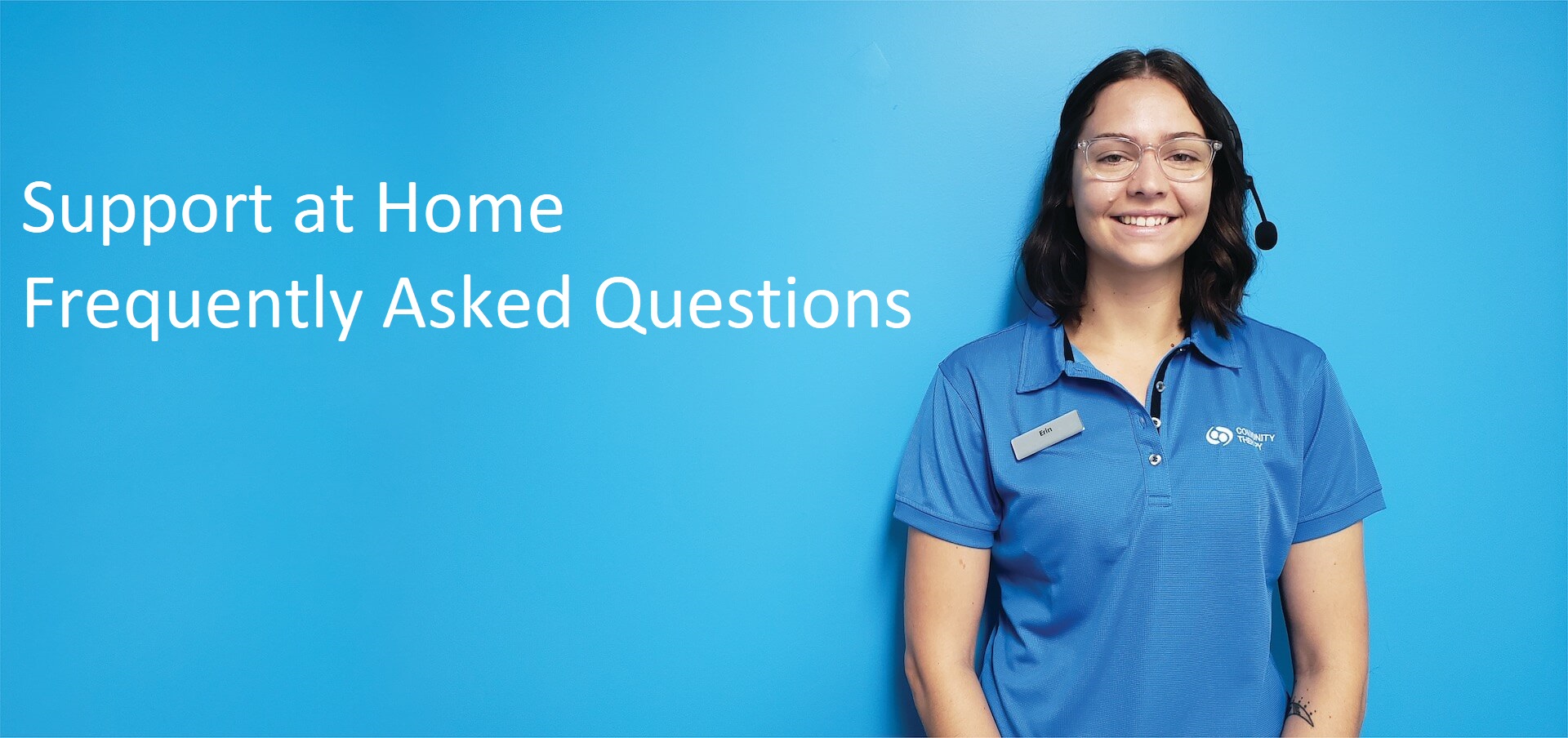The Support at Home program represents one of the most significant reforms in aged care, designed to streamline and simplify the way older Australians receive support in their homes.
At Community Therapy, the transition to our Support at Home program has been led by our founder, Scott Lynch.

Scott is a Physiotherapist by background, has served as Vice Chair of the Australian Physiotherapy Association’s Gerontology Committee and currently sits on the Department of Health, Disability and Ageing’s Quality Indicator Technical Reference Group.
In this article, Scott has shared the most common Support at Home allied health questions asked by registered providers and participants.
After reading this, you will have a better understanding of:
- How the program works (assessments & funding)
- Documentation
- Transition
- Compliance
We hope to share information that can collectively improve our understanding of the program, and deliver compliant, person-centered care.
How does an older adult access Support at Home funding?
For an older adult to access services under Support at Home, they must first undergo an aged care assessment.

During this process, an aged care assessor uses the Integrated Assessment Tool (IAT), which determines the person’s Support at Home classification level based on their responses and functional needs.
Once the assessment is complete, the older adult can either accept or decline the classification.
If they accept, they become a Support at Home participant and can then choose to have a registered provider to manage their package or self-manage their own Support at Home funds.
It is important to know that many participants transitioned to Support at Home from the Home Care Package program as well.
How will providers transition existing clients into Support at Home without service interruptions?

Registered providers are legally responsible under the Aged Care Act for ensuring continuity of care during the transition from Home Care Packages or Short-Term Restorative Care to Support at Home.
This involves:
- Entering into new service agreements with participants.
- Applying updated contribution rules.
- Maintaining ongoing clinical service delivery without disruption.
The transition rules can be complex, particularly around contributions in the first 90 days, and providers are encouraged to refer to departmental resources for clarity and implementation guidance.
Is the aged care assessor always a clinician?
Not always.

Aged care assessment organisations include both clinical and non-clinical assessors.
- Clinical assessors are typically assigned when the person has complex care needs, such as nursing, pressure area care, advanced equipment, or home modifications.
- Non-clinical assessors often handle cases involving lower-level support, such as domestic assistance, gardening, or light allied health involvement — usually for individuals suited to the Commonwealth Home Support Program or a lower Support at Home classification.
This distinction is determined during a pre-assessment phone screen by the aged care assessment organisation, ensuring the right type of assessor visits the home based on the person’s needs.
Are aged care or allied health providers involved in the assessment process?
No, the initial assessment and classification are handled by the aged care assessment organisations.

Once a person’s classification level has been set, the registered provider will conduct an initial home visit to collaborate with the participant and their family.
Together, they decide how to best use the available funding to meet ongoing care needs and personal goals.
What’s the difference between self-managed and provider-managed Support at Home packages?

Many in the sector report that the key difference lies in fees and oversight.
- Self-managed participants typically pay lower service fees as providers cannot charge more than 10% on top of services. Usually, a participant will require a level of informal support from a partner, family or friends to self-manage.
- Provider-managed participants typically pay higher fees, but many in the sector would argue that the level of clinical governance, safety, and quality assurance is higher. This is particularly valuable for those without strong family or informal support networks.
Are there new forms for assistive technology, home modifications, or risk assessments?
Yes. Since the program’s launch in November, new forms have been introduced, including:
- An Assistive Technology funding request form (for funding beyond the $15,000 cap).
- An End of Life Pathway application form
Additional forms are expected to follow, supporting consistency in application and reporting processes across providers, participants, and government systems.

Also, you can read more about Community Therapy’s related services here:
- Assistive Technology Under the Support at Home Scheme
- End of Life Pathway Under the Support at Home Scheme
For other processes and forms, such as risk assessments, providers are guided by the Aged Care Quality Standards, which outline expectations for risk management, incident management, and complaints handling.
It is important to also note that registered providers must also meet new compliance obligations, including having a whistleblower policy and maintaining systems for the Serious Incident Reporting Scheme (SIRS) so they will likely have updated internal forms related to these.
How do providers monitor participant spending and budgets?
Under Support at Home, providers use their software systems to monitor each participant’s quarterly budget.

They also have access to participant data via the Services Australia portal.
How do providers maintain evidence that services are delivered in line with Support at Home guidelines?
The program outlines detailed evidence requirements depending on the service type:
- Some services require participant signatures at each visit as proof of delivery
- Allied health services generally require an invoice and proof of attendance on request, such as a progress note or report
- For assistive technology or home modifications, providers must submit specific evidence such as signed delivery slips, item photos, and related documentation
Across all services, every interaction and invoice must be supported by a corresponding documentation entry in the provider’s system — ensuring accurate claims and compliance with program rules.

General FAQ
Can I get help with housework and laundry?
Yes, domestic assistance services are part of the “Everyday Living” category. This includes general house cleaning and laundry services.
Can I get help with home maintenance and repairs?
Yes, the Support at Home program covers minor repairs and maintenance that you used to be able to do yourself. This could include activities like:
- Replacing tap washers
- Changing batteries in smoke alarms
- Cleaning gutters
This service does not cover major jobs that require a professional tradesperson, such as painting, installing decking, or servicing your heating and cooling systems.
What support is available for meals and nutrition?
The Support at Home program can support meal delivery and if you have specific dietary needs, you may also be able to access the prescribed nutrition.
This covers supplementary dietary products that have been prescribed by a Dietitian for needs related to age-related functional decline.
Can I use my funding for allied health?
Yes, services like physiotherapy, occupational therapy, speech pathology, dietetics, exercise physiology, podiatry and more are available under the allied health and other therapeutic services category.
Other allied health services, such as chiropractic and massage, fall under the independence service category.
What kind of support can I get with my medications?
Support with medication is available under both nursing care and personal care services. The type of support you can get depends on your care plan and the qualifications of the worker.
Are continence products covered? Yes, but they are funded in two different ways depending on the type:
- Disposable Products: Items that are used once and replaced often (like pads, catheters, and sheaths) are covered under nursing care consumables.
- Reusable Products: Some washable and reusable items (like urine bottles, washable absorbent products, and washable underpads for chairs or bedding) are covered under the Assistive Technology and Home Modifications (AT-HM) scheme
I currently use the Continence Aids Payment Scheme (CAPS). What is happening to it?
The rules for CAPS are changing as Support at Home is introduced.
- From 1 November 2025, there will be no new CAPS approvals for Support at Home participants
- From February 2026, CAPS eligibility will end for all Support at Home participants. You will access your continence products through your Support at Home funding instead
How does transport assistance work?
The transport service is designed to help you get to and from your usual activities, such as appointments, shopping centres, or social clubs.
There are two types:
- Direct Transport: A driver and car are provided to take you
- Indirect Transport: You receive vouchers for taxis or rideshare services (like Cabcharge)
This service is for when you are able to attend the activity on your own and just need help with the travel.
What if I need someone to stay with me at my appointment?
If you need a support worker to go with you, assist you out of the car, and stay with you during the activity, this is a different service. This would be funded under a service like accompanied activities .
What is the Assistive Technology and Home Modifications (AT-HM) scheme?
This is the scheme used to fund products, equipment, and changes to your home to help you stay safe and independent. It can also pay for wraparound services, which include delivery, set-up, and training on how to use the equipment safely.
I am transitioning from a Home Care Package (HCP). How can I use my unspent funds for equipment?
If you are transitioning from an HCP, you can use your unspent funds to purchase items from the AT-HM list.
- When using unspent funds, the $15,000 cap on home modifications does not apply.
- If you pay for 100% of an item using your unspent HCP funds, no participant contribution is required.
- If you partially pay with unspent funds and partially with your new Support at Home budget, you will only pay a contribution on the portion from the new budget.
How do I pay my contribution fees?
Registered providers may have different payment schedules that can range including weekly, fortnightly, or monthly.
What if I am experiencing financial hardship and can’t pay my fees?
If you are experiencing financial hardship, you can apply to the government for a fee reduction. If your application is approved, the government will pay for some or all of your fees. You cannot be charged any fees while your hardship application is being assessed.
How is the contribution information determined?
Services Australia notifies the participant of their contribution rate after their income and assets assessment is complete. For new participants, this can be done before they enter a service agreement. For pensioners, this information is often matched automatically (Source 2128).
What Support at Home levels do the Home Care Package levels correlate to?
This is a key point of confusion. A client transitioning from HCP keeps their equivalent funding level. The Support at Home manual provides an explicit table:
- HCP Level 1 -> Transitioned HCP Level 1
- HCP Level 2 -> Transitioned HCP Level 2
- HCP Level 3 -> Transitioned HCP Level 3
- HCP Level 4 -> Transitioned HCP Level 4
A client is only moved to one of the new Support at Home classifications (Levels 1-8) if they are re-assessed.
What are the grandfathering rules?
Based on the program documents you provided, the “grandfathering” rules refer to specific provisions for former Home Care Package (HCP) recipients to ensure they are not disadvantaged under Support at Home.
These rules primarily apply to participant contributions and the Dementia and Cognition Supplement.
1. Who is a “Grandfathered” Client?
A grandfathered HCP care recipient means on or before 12 September 2024 they were either:
- Receiving a Home Care Package
- On the National Priority System waiting for a package
- Assessed as eligible for a package
A grandfathered participant will have a ‘no worse off’ rule with respect to contributions where they will be the same or lower than what they would have paid under the old home care package program.
Here is how it works:
- For Grandfathered Full Pensioners: If you are a full pensioner and were not required to pay an income-tested care fee under the old HCP program, you will continue to make no contributions (0%) for all your Support at Home services.
- For Other Grandfathered Clients: If you were paying an income-tested care fee (e.g., as a part-pensioner or self-funded retiree), you will pay special discounted contribution rates that are the same or less than what you paid before.
These grandfathered contribution rates apply even if they are re-assessed into a higher Support at Home classification in the future.
There is an additional grandfathering rule for the dementia and cognitive supplement. If a participant was an existing HCP client receiving the Dementia and Cognition Supplement as of 31 October 2025, they will continue to receive it when they transition to Support at Home.
However, if they (as a grandfathered client) are re-assessed and accept a new Support at Home classification, the supplement will cease. This is because the new classification framework is designed to already include consideration of a person’s cognitive ability in its funding level.
When do quarterly budgets run from?
Quarterly budgets are released at the beginning of July, October, January, and April. The first period (1 Nov 2025 – 31 Dec 2025) will be a pro-rata rate.
Are personal alarms or falls monitors covered under the Support at Home program?
Yes, these are funded. Personal emergency alarm systems are an inclusion on the AT-HM list.
- Ongoing costs like monitoring fees are considered integral to the operation of the item and are funded.
- Noting that they are considered a part of the product on the AT-HM list, the participant contribution rate would be equivalent to the independence category.
- They must be prescribed by a suitably qualified allied health professional which includes an occupational therapist, physiotherapist, or speech pathologist.
Is a vacuum cleaner funded under Support at Home?
Yes. Vacuum cleaners are listed as an inclusion.
What size beds or mattresses are approved under Support at Home?
The AT-HM list includes beds and detachable bed boards/mattress support platforms with manual adjustment and powered adjustment as inclusions. It does not specify a size limit, only that the item must meet the participant’s assessed need.
How do you apply for AT-HM for a transition client with no unspent funds?
The AT-HM Guidelines state that if a transitioning HCP client has insufficient unspent funds, the provider can either:
- Use the AT-HM scheme data collection process to get a funding tier allocated (Source 4350, 4373); or
- Request a “Support Plan Review”
Can pool or gym entry fees be covered in Support a Home?
The Support at Home service list does not cover pool or gym memberships.
It does however note that a provider can factor the gym or pool entry into their unit price or have participants pay for entry themselves.
Where do prescribed supplements fall under Support at Home?
These are funded under the prescribed nutrition clinical service. They must be prescribed by an Accredited Practising Dietitian or an AHPRA-registered health practitioner” (which includes a GP). There are no contributions as they fall in the clinical category.
Key Takeaways
There is a lot to learn about the Support at Home program.
So if you have any questions, you are welcome to contact us via our contact page and we will get back to you with an answer.


 November 27, 2024
November 27, 2024

